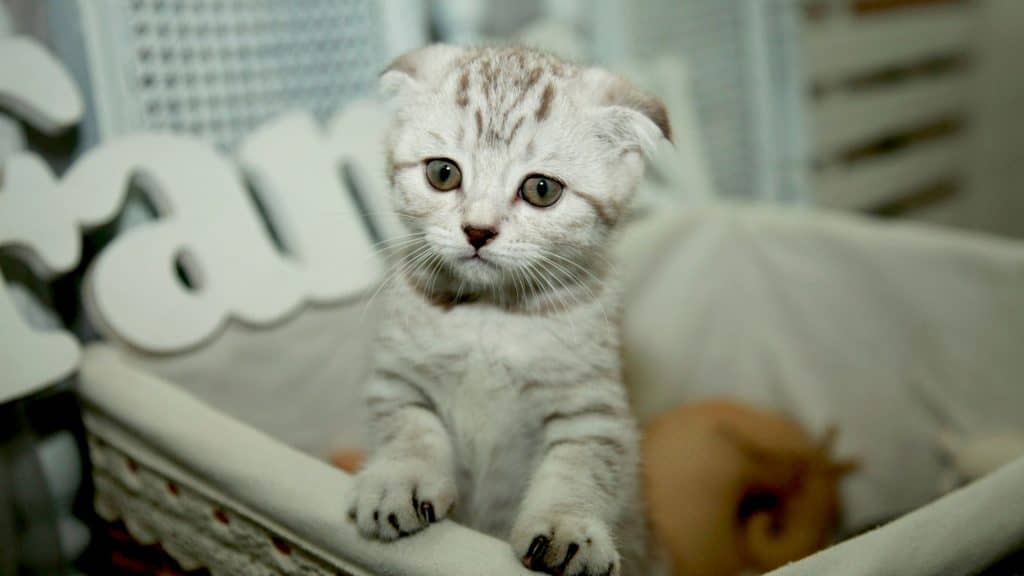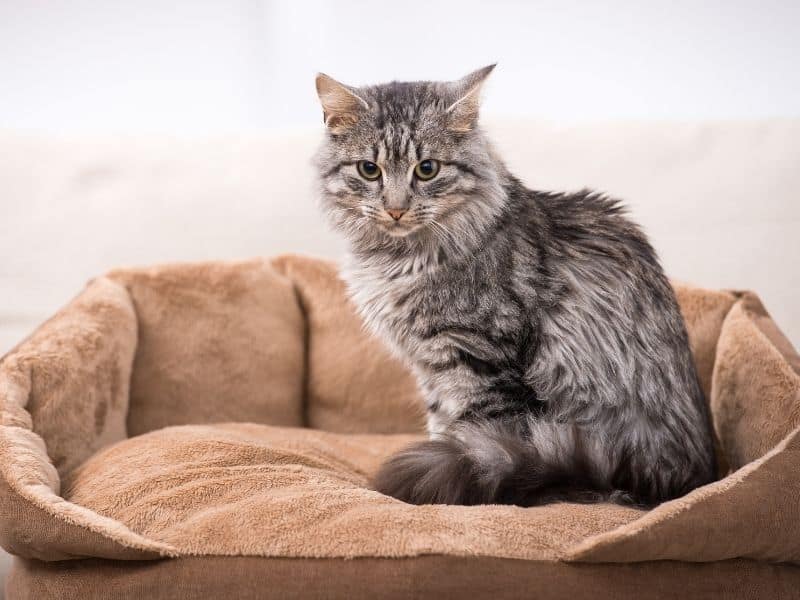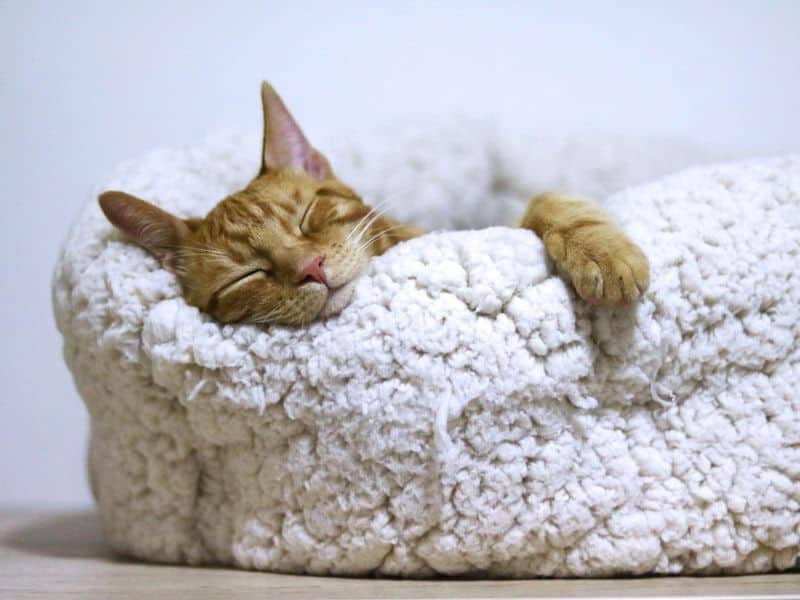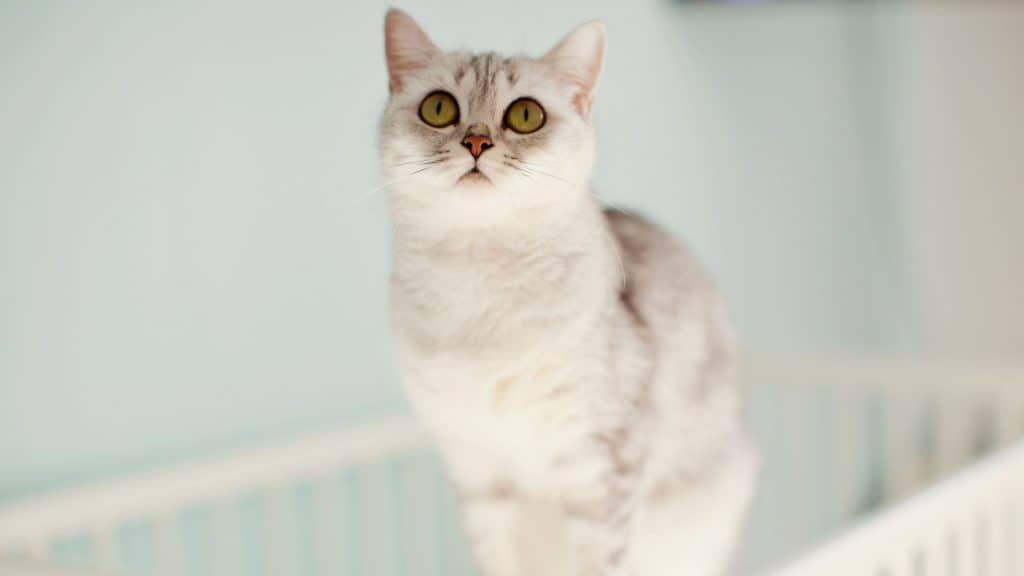Even for the feline connoisseurs, keeping the cat out of the baby’s crib without much fuss is a head scratcher.

Well, I have bad news, funny news (kinda), and good news.
The bad news
This is not an issue you can shrug off. I wasn’t even aware of how serious it is until I started researching for this guide.
I just finished reading a news report about a hissy cat in Oregon that attacked a baby and forced a whole family (and their dog) to barricade themselves in a bedroom and call 911.
The police report reads, “The cat remained behind bars in the custody of the family, and officers cleared the scene and continued to fight crime elsewhere in the city.”
It would be funny if the context were different.
The good news
The good news is that there are simple techniques you can use to keep a cat out of your baby’s crib.
We’ll go through nine of the most effective ones.
The first five tips work if you’re still expecting, and tips 6-9 are for parents living the problem right now.
For a slightly different approach, check out my tips for keeping your cat out of the bassinet.
How to keep cat out of crib – 10 tips
1 – Train the cat before the baby arrives
Set up the crib well ahead of the due date.
There’s no precise rule here – the sooner, the better. It will give you more time to see how interested the cat is in the crib (if at all) and take action if you need to.
Don’t make the mistake of thinking that it all stops there if the cat ignores the crib.
It doesn’t.
Because part of the crib’s appeal to the cat is the new life and sound that will soon be coming from it.
Nevertheless, you can use the time to ‘teach’ the puss to stay away from the crib.
2 – Give the cat an alternative
Think about getting a comfy pet bed that would distract the cat from the crib.
In an ideal world, you’d already own one. You want a place that’s so cozy that a cat loses interest in anything else, including the crib.
The ‘motivation’ behind jumping into a crib will vary from cat to cat. We’re not even going to try and decipher that.

For some of them, it just looks like a cozy spot to rest their whiskers. If that’s the case, giving them an alternative will work wonders
Again, try it before the baby arrives.
3 – Planned scolding
If you have the crib and the comfy alternative set, avoid leaving the cat in the room alone.
They might get into the crib and, if it goes without consequence, they’re getting the message that the crib is fair game.
Instead, plan to let your cat in the room while you’re nearby, get it out if it climbs into the crib, and scold it. Start mildly and ramp the scolding up if it keeps happening.
Establish a chain of events – the cat gets in, you get it out and scold it, you place it where it belongs (ideally the cozy bed we mentioned above).
Be firm and let the cat know that the crib is off-limits.
4 – Use classical conditioning
If things go as planned, the scolding should soon be enough for the cat to get out of the crib on its own.
If that doesn’t happen, ramp things up by making it uncomfortable for the cat to stay in. A good way to do it is to play a loud, high-frequency sound.
They hate that. It annoys the heck out of them.
If they build a crib-annoying-sound connection, you’re golden.
You don’t need anything special to do it; just go to YouTube, search for “High-Frequency Sound To Annoy Cats,” and play it on max volume from your phone every time the cat decides to get into the baby’s crib.
The bad part here is that the sound is annoying to humans too, which renders it useless once a newborn baby arrives. Instead, get a high-pitched whistle that only a cat can hear.
I should warn you that, once you realize the power of conditioning, you’ll want to use sound or a sonic device to change other behaviors you don’t like.
Don’t do it.
Keep the connection you built exclusive to the crib; it’s more reliable long-term.
Note: I’d love to tell you that positive reinforcement like rewarding the cat for getting out of the baby’s crib will also work. For most cats, it won’t.
There are just too many variables, and you might end up confusing the cat. Using something a cat dislikes works much better.
You can use positive reinforcement but keep it entirely out of the crib context. When you see the cat sleeping where it should, you can reward it.
5 – Use Aluminum foil to keep the cat out
If you’re into social media, you probably saw this one coming because it’s all over the place.
People are covering cats’ favorite surfaces (like kitchen tops) with aluminum foil to see if they’ll freak out.
I’ve seen it work like a charm, and I’ve seen it fail miserably.
Still, it’s fair to say that most cats don’t like it. It’s because of the noise, the crinkly texture, and the reflectiveness.
Cover the baby crib mattress with foil and see if your cats dislike it. If it works, it’s a sure-fire recipe to keep your cat out of the new baby crib.
6 – Use double-sided tape
This works in the same way and for the same reasons as an Aluminum foil.
Typically, cats hate anything that sticks to their paws and will jump out of the crib the moment they feel it on the mattress.
Like foil, it doesn’t work on all cats, and some gutsy marauders won’t be phased by it.
The only way to know for sure is to try it. It doesn’t even have to be on the mattress; just place a few pieces around a place where they hang out and see what happens.

If it annoys them, use it in the crib.
Get creative with it
You can use double-sided tape to keep your cat away from other surfaces in the baby’s room, too – ones they might use to jump into the crib.
7 – Clear the space around the baby’s crib
If possible, keep the area around the crib free of any pieces of furniture that a cat might use to propel itself into the crib.
If you’re not sure
If you’re working with a small space and are unsure if a cat can use something or not, it’s best if you stay away from this tip altogether.
The worst you can do here is ‘force’ the cat to use a high or distant surface to launch into the crib. That’s the kind of force that can seriously hurt a new baby.
If in doubt, stick to the other techniques.
Ultimately, how applicable this tip is will depend both on your space and the baby bed – not the same rules apply to bassinets, cradles, pack’n’plays, and cribs.
Related reads: bassinet vs. cradle vs. crib | mini crib vs. crib | crib alternatives | pack-n-play vs. crib | travel crib vs. pack-n-play |
8 – Use smells in the baby’s room
Cats can’t stand citrus smells.
You can use this in two ways:
- Keep your cat out of the baby’s room when the newborn is already in there
- Condition the cat to think that the room always smells ‘citrusy.’
The latter is the safer way to go because it’s not advisable to have strong smells in a baby’s nursery or sleeping environment.
A slice of lemon at the doorstep is OK, but fragrant products inside are not, especially if they’re synthetic.
If you use the months before the due date to condition the feline friend to think the room smells like citrus, it’s likely to stay away.
The problem with smell as a cat deterrent
Most pet owners don’t like the idea of keeping their ‘fur baby’ entirely away from the child’s room. They’d prefer to manage the situation so that the two can safely co-exist.
If you don’t want to keep your cat completely out, skip this tip.
I should mention, however, that most experts advise keeping the cat away from a newborn baby for reasons beyond physical harm, like hair and dander.
Bonus tip: I’ve seen Peppermint oil mentioned time and again in this context.
These are the facts – it is a potent cat deterrent. That much is true.
But unlike citrus smells, it’s unsafe for cats. The reaction to peppermint can range from being annoyed to aspiration pneumonia. For your gato’s sake, stay away from it.
Related reads: can a baby sleep in a travel crib | can a newborn sleep is a crib | transitioning from crib to bassinet
9 – Install a screen door
A screen door is a middle ground between barring the cat from the room altogether and going through the hassle of controlling it.
A cat is territorial and curious. If you bar it from a space it’s interested in; a cat will spend nights trying to wiggle its way back.
You don’t want that.
With a screen door, you’re giving them a glimpse of the action. The cat will feel like it’s a part of everything that’s going on. That’s crucial.
Make sure they can see the baby at times, so they understand what the fuss is about. That will mitigate their burning curiosity.
That’s where you want them – calm and in the loop.
10 – Don’t make drastic changes in attention or space
Cats don’t like too little attention, and they don’t like too much attention. They also hate change.

All of the above is likely to happen with the arrival of a newborn.
I know it’s commonplace advice, but it’s important – try to maintain some semblance of continuity in attention and space your cat gets.
Plan for some 1-on-1 time with your mouser.
If too much changes too quickly, it’ll get fussy and much harder to control. And that goes for keeping them out of a baby crib, too.
Cats and cribs – the bottom line
You have two main problems when trying to keep the cat out of the crib – they don’t like competition, and they despise drastic change.
But they’re also smart animals that can recognize the vulnerability of a human baby and adjust.
The tips above cover the full spectrum of your cat’s potential reactions.
No 911 for you!
Paul is a passionate dad who founded Upside Dad to share his parenting journey with other new parents. He graduated from Concordia University and worked as a test engineer for over a decade. Paul loves dad jokes and craft beer.
Learn more about Paul and Upside Dad here.
